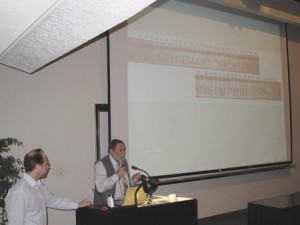Armen Arikian
Staff Writer

Photo: Barlow Der Mugrdechian
Thirty-six uniquely shaped symbols represent the Armenian alphabet. St. Mesrop Mashtots is honored and remembered as the father of the Armenian alphabet, created in 406 AD. How did Mashtots manage to organize and discover the written Armenian language?
Independent scholar Serge Mouraviev, a French-Russian philosopher, presented his lecture, “The Secret of Mashtots’ Yerkatagir” at the University Business Center at Fresno State, on April 12th. Mouraviev educated the audience on how Mashtots formed the Armenian alphabet, and where the earliest examples of the Mesropian language originated from.
Mouraviev devoted many years of his life to studying the original Armenian alphabet, yerkatagir [the iron letters-capital letter], the uppercase letters of the alphabet, which was later succeeded by poloragir, which included the lowercase letters of the Armenian alphabet. Mouraviev’s inspiration to study the origins of the Armenian alphabet started in 1978 after having traveled to Armenia several times.
Mouraviev noticed that an earlier alphabet known as the Danielian letters, is quite similar to the later formed yerkatagir alphabet. Mouraviev displayed many charts comparing the Danielian and Armenian alphabets. He pointed out many similarities in the shapes and sounds of the letters, using elaborate charts to support his theory.
The order of the Danielian and Armenian alphabets are nearly identical with a few minor differences. Mouraviev theorizes that Mashtots modified the now extinct Danielian alphabet to form the Armenian alphabet.
Mouraviev identified two main elements shared by the Danielian and Armenian alphabets. The primary distinction involves a U shape similar to the one in the Latin alphabet. This element is often seen in the present-day Armenian alphabet in capital letters such as ‘ayp’, ‘she’ and ‘men.’ The secondary distinctions are the horizontal lines that are used in many Armenian letters. According to Mouraviev, Mashtots used five basic Danielian letters to form 20 Armenian letters.
Mashtots altered nineteen of the twenty letters. He kept seven primary distinctions, six secondary distinctions, six secondary with modifications of basic elements, and one unchanged Danielian letter. Mouraviev explained that Mashtots took the original shapes of the Danielian characters and made slight adjustments to them. Mashtots altered primary elements by adding or removing certain lines or curves of the Danielian characters. In the secondary elements, Mashtots replaces horizontal lines of the Danielian characters, with vertical lines, to form new Armenian letters.
The first twenty letters of the yerkatagir alphabet were old Danielian, and later four were newer Danielian. Thirty-six letters form the modern-day alphabet, which meant that Mashtots needed twelve more letters to complete the alphabet. He created the remaining letters by shifting existing Armenian letters by a specific amount of degrees to form letters to represent different Armenian sounds.
Mashtots’ formation of the 36 letters of the Armenian yerkatagir alphabet has sparked debate as some believe that Mashtots’ letters were completely new. The similarities between the Danielian and Armenian alphabets could be coincidental, but according to Mouraviev, the chances of that many similarities being accidental are very unlikely. He also suggested the reason the.
All of Mouraviev’s theories and charts are included in his book, Erkataguir: Les Trois Secrets De Mesrop Machtots (in French).
Mouraviev described and displayed the earliest visual example of Mashtots’ alphabet, which was a monument dedicated to the unknown soldiers in Jerusalem. The monument was built by Bishop Jacob and the Catholicos between the fifth and sixth centuries. The Armenian inscription on the monument devoted to the memorial of the unknown soldiers reads “For the salvation of all Armenians, whose names only the Lord knows.” The effort and thought devoted to the original yerkatagir alphabet nearly sixteen centuries ago made the modern written Armenian language a reality. Mashtots’ creation of the Armenian alphabet has been thoroughly examined by not only Mouraviev, but also many other scholars. Whether or not the Mashtots alphabet was based off another alphabet or completely original, years of effort were dedicated to forming a written language for the Armenian people that still exists today. The Armenian culture is one of the few to have an alphabet whose even oldest inscriptions can be read to the present-day.
 Hye Sharzhoom Armenian Action
Hye Sharzhoom Armenian Action